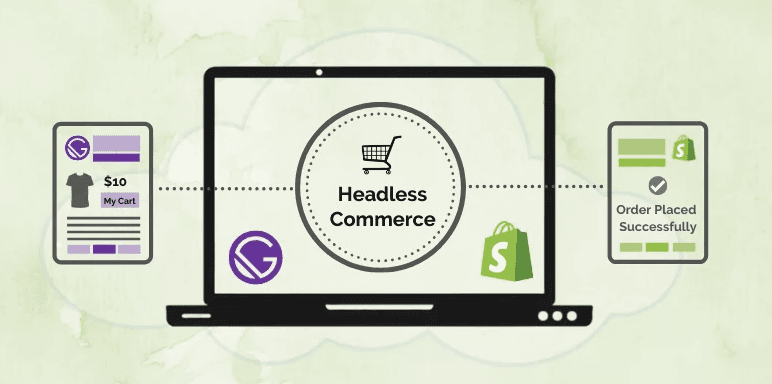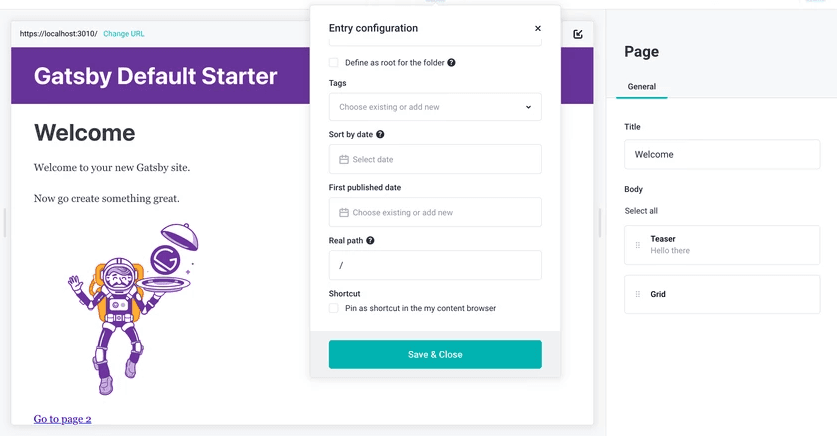How Headless Shopify with Gatsby Can Benefit Your Business

Ecommerce is all about speed. You lose revenue every time a page on your site loads slower. This could be millions of dollars, depending on your business size. Specifically, conversion rates drop by approximately 4.42% with every additional second it takes the page to load (between 0 and 5 seconds).
Gatsby is one of the best frameworks to get fast speed out of the box. Shopify is one of the best ecommerce platforms for online stores. Together, the two ecommerce solutions make an invincible team.
This powerful combination is what this article is about. We give you the lowdown on how integrating headless Shopify with Gatsby can create a faster and more customizable ecommerce experience that puts your business on a path to excellence.
Let’s dive right in.
What Is GatsbyJS?
GatsbyJS is an open-source framework for building static sites and web applications, including progressive web apps (PWAs). It is designed to create fast, performant, modern web experiences.
Because Gatsby generates static HTML, CSS, and JavaScript files at build time, it can deliver extremely fast loading times and improved SEO performance compared to traditional dynamic websites.
The Gatsby framework is React-based, meaning it is built on top of React, a popular JavaScript library for building user interfaces. So, it allows you to leverage React's component-based architecture to create interactive and dynamic web content.
The framework uses the powerful GraphQL language for data querying and manipulation. With this language, you can pull in data from various sources like APIs, databases, or Markdown files and efficiently manage it on your website.
What Is the Shopify Gatsby Theme?
Theme is a term thrown around often, but what exactly is it? As far as web development is concerned, the theme is the fabric for the completed website design. It comprises typography, page layouts, color palettes, backgrounds, headers, and footers.
When you put all of these site elements together, you get the theme. Though we have not mentioned it, you should have noticed that all these elements apply to the front end.
So, to put it better, a website theme is the fabric managing the front-end design that establishes the overall appearance and functionality.
A headless Shopify Gatsby theme, therefore, applies to the Gatsby side of the architecture. When you have a headless Shopify and Gatsby working together, the Shopify solution deals with the back-end functionality, while Gatsby handles the front end, the theme side.
With Gatsby themes, you can decompose a website into logical units. This is designed to ensure lightning-fast storefronts for compatible ecommerce platforms like Shopify.
Integrating Headless Shopify with Gatsby: What You Must Know

As the name suggests, headless Shopify does not have a built-in front end. While you could use various third-party technologies to create that missing piece, choosing GatsbyJS, a static site generator based on the ReactJS library, can have many benefits.
Simply put, the combination of headless Shopify and Gatsby creates high-performance, fast-loading ecommerce sites. Here is why:
Gatsby is built for speed, making it one of the very best frameworks for achieving lightning-fast website speeds out of the box.
Shopify is more than a SAS product. It is a robust ecommerce platform with an app ecosystem that allows for building on top of it.
Shopify offers a source plug-in for Gatsby integration. This tool lets you pull and push content, products, and services from Shopify into your Gatsby website at incredibly fast speeds.
When you put these two together, you have a combination of solutions, each doing what it does best. The result is an amazing website that loads in milliseconds, is easy to customize, and delights your ecommerce visitors.
How Headless Shopify with Gatsby Can Benefit Your Business
Welcome to the moment of truth. We now have adequate background information about Gatsby and headless Shopify. We also know the reasoning behind integrating and using them together.
More specifically, headless Shopify and Gatsby make the perfect combination for developing and creating fast and efficient ecommerce websites.
But how can this translate to your business?
Your site’s speed and performance directly correlate to its conversion rates. Faster is always better when a site’s speed is concerned.
Let’s break it down below.
Increased organic traffic and conversions due to faster page load speeds
Thanks to static HTML, JavaScript, and CSS files generated at build time, the Gatsby framework can deliver the fastest possible user experience.
It serves statically generated, optimized website content and media to users on a secure, global content delivery network (CDN).
Gatsby builds the entire website at build time and keeps it on an edge CDN. Therefore, users do not have to wait for server response times to access the website. This leads to speedy access and lots of other performance-related advantages.
Naturally, such great speeds mean the end user can quickly get what they want, enhancing their experience. For an ecommerce site, fast page loads mean visitors can access your products and services quickly, resulting in more conversions.
You can expect your ecommerce site to enjoy the highest conversion rates if the pages load within 0 to 2 seconds.
Using Gatsby for your headless Shopify front end can deliver such speeds. The integration allows you to leverage Gatsby’s static-site-generating approach associated with dramatic impacts on time to first paint, page load speeds, and other user experience metrics comprising Google’s Core Web Vitals measurement.
And the beautiful part is that these advantages are not limited to a certain business size. Online retailers are faster with Gatsby regardless of their sizes.
Gatsby sites are extremely scalable. So you can give your ecommerce visitors the same satisfactory experience with optimal web-page performance whether you’re selling a hundred or a hundred thousand products.
The combination gives you more creative control
If you have worked with legacy systems to run your ecommerce business online, you must have identified something you wished could be better. Even with the best-performing solution, you often find yourself wishing something could be different.
Legacy ecommerce platforms usually have a front-end component that lets you customize a few things to build your site. There is usually a template that speeds up the building process. However, it also limits the amount of wiggle room you have with your customizations.
Fast forward to the era of headless Shopify and Gatsby, and you have more control over your website's functionality and user experience.
For starters, the headless Shopify comes with no front-end component or the customer-facing presentation layer comprising the user interface. And with that architecture comes the freedom to build your customer presentation layer the way you want, deciding every aspect.
Gatsby is designed to simplify the building of creative Shopify headless ecommerce sites that integrate with third-party systems, including your favorite CMS, review system, and form provider.
This feature allows you to include in your Headless Shopify Gatsby integration—whatever your business needs to engage more traffic and drive more conversions.
Your developers can ship essential features faster
The headless Shopify Gatsby integration is only possible because of headless Shopify's decoupled architecture that separates the front-end from the back-end functionality.
With this architecture, two teams can work on your ecommerce site simultaneously. One team of developers can work on the Gatsby framework while another sets up the headless Shopify back end.
This way, the front-end developers can add new products, build new features, and more in less time. Even better, Gatsby gives them the tools they need at every step, including GraphQL, Git, and many more.
Whatever features your business needs to get up and running, it can have it much sooner, thanks to having two teams working simultaneously.
It lets you connect your favorite CMS for a unified experience
When you think about the content management system (CMS) where a headless Shopify with Gatsby is concerned, Contentful may easily come to mind. It is the most common headless CMS used with Gatsby. However, this should not trick you into thinking it’s the only choice.

Both headless Shopify and Gatsby are designed to integrate and work seamlessly with any API-first CMS. This means your options are limitless. You can use your preferred CMS, including WordPress and Contentful, and create a perfectly unified experience with content and data from your suite of web services.
Gatsby is an excellent static site builder. Shopify excels as an ecommerce platform. Both Shopify and Gatsby are API-first solutions that work seamlessly with essential third-party integrations.
Gatsby actually abstracts the Shopify API, allowing front-end developers to create more innovative web experiences using a modern Git-based workflow.
However, none of these solutions are built with content management as their primary strength. This is where a headless CMS comes in.
Without pairing your Gatsby website with a CMS, you’ll need to make any content changes through code. That might be less than ideal. So, go ahead and pick WordPress or Contentful, whichever CMS you’ve used to edit content, add images, and create new posts before.
Integrate that choice into your headless Shopify with Gatsby ecosystem and enjoy enhanced performance, faster build times, and a greatly improved developer experience.
You can drive engagement and sales with PWA out of the box
Gatsby offers PWA (progressive web app) functionality out of the box. This means you are getting offline mode, home screen icons, push notifications, and more within a single solution; no need to spend lots of time developing them.
PWAs are an excellent means of retaining customers. They improve visitor engagement and guarantee faster loading times even over slow or unreliable networks. This can go a long way in driving conversions and increasing sales.
What could be better than allowing customers to access your ecommerce content even while they’re offline?
It guarantees the safety and security of your customer data
You may already know that Gatsby serves data as a static asset. When you build your ecommerce storefront with this solution, all the sensitive customer data remains safely protected in the back end.
Since the front-end layer communicates with the headless Shopify back end via APIs, there is no open connection to the database in the back end. This goes a long way in mitigating any attack vectors in the front end.
Recap: How Headless Shopify with Gatsby Can Benefit Your Business
Well, there you have it. Everything you should know about Gatsby and its integration with headless Shopify. We have pointed out that having a headless Shopify with Gatsby can benefit your business by:
Guaranteeing the safety and security of your customer data
Driving engagement and sales with PWA out of the box
Letting you connect your favorite CMS for a unified experience
Facilitating the quick shipping of essential features
Giving you more creative control
Increasing your site’s organic traffic and conversions with faster page loads
Keep an eye out for rich insights on implementing headless Shopify properly in our next post.
We hope this guide helps you out. If you need more help, don’t hesitate to schedule a free consultation with the Gatsby experts at Endertech.
